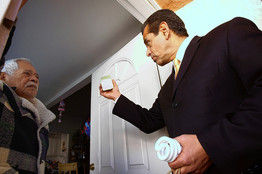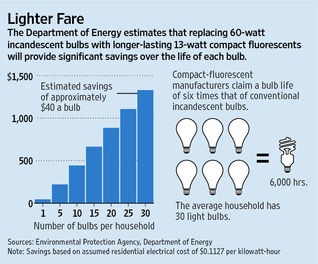
California's utilities are spending $548 million over seven years to subsidize consumer purchases of compact fluorescent lamps. But the benefits are turning out to be less than expected.
One reason is that bulbs have gotten so cheap that Californians buy more than they need and sock them away for future use. Another reason is that the bulbs are burning out faster than expected.
California's experience is notable because energy experts have placed high hopes on compact fluorescent lamps. Often spiral-shaped, they screw into existing light sockets and offer energy savings of about 75% over traditional incandescent light bulbs.
Many nations are relying on them to help cut emissions from power plants and stretch electricity supplies further. The United Nations says 8% of global greenhouse-gas emissions are linked to lighting, and that adoption of compact fluorescent lights could cut pollution.
The World Bank has helped dozens of mostly poor nations begin the switch to the bulbs to make electric lighting more affordable. Last June, for example, Bangladesh gave away five million of the bulbs in a single day.
No state has done more to promote compact fluorescent lamps than California. On Jan. 1, the state began phasing out sales of incandescent bulbs, one year ahead of the rest of the nation. A federal law that takes effect in January 2012 requires a 28% improvement in lighting efficiency for conventional bulbs in standard wattages. Compact fluorescent lamps are the logical substitute for traditional incandescent light bulbs, which won't be available in stores after 2014.
California utilities have used ratepayer funds to subsidize sales of more than 100 million of the bulbs since 2006, most of them made in China. It is part of a comprehensive state effort to use energy-efficiency techniques as a substitute for power production. Subsidized bulbs cost an average of $1.30 in California versus $4 for bulbs not carrying utility subsidies.
Anxious to see what ratepayers got for their money, state utility regulators have devoted millions of dollars in the past three years for evaluation reports and field studies. What California has learned, in a nutshell, is that it is hard to accurately predict and tricky to measure energy savings. It is also difficult to design incentive plans that reward - but don't overly reward - utilities for their promotional efforts.
When it set up its bulb program in 2006, PG&E Corp. thought its customers would buy 53 million compact fluorescent bulbs by 2008. It allotted $92 million for rebates, the most of any utility in the state. Researchers hired by the California Public Utilities Commission concluded earlier this year that fewer bulbs were sold, fewer were screwed in, and they saved less energy than PG&E anticipated.
As a result of these and other adjustments, energy savings attributed to PG&E were pegged at 451.6 million kilowatt hours by regulators, or 73% less than the 1.7 billion kilowatt hours projected by PG&E for the 2006-2008 program.
One hitch was the compact-fluorescent burnout rate. When PG&E began its 2006-2008 program, it figured the useful life of each bulb would be 9.4 years. Now, with experience, it has cut the estimate to 6.3 years, which limits the energy savings. Field tests show higher burnout rates in certain locations, such as bathrooms and in recessed lighting. Turning them on and off a lot also appears to impair longevity.
California regulators have debated whether utilities should be held to the energy savings they promised in order to earn bonus pay. Staff of the state utilities commission said utilities missed their overall-energy savings targets, partly because of disappointing results from light bulbs. Utilities disagree with many of the staff's conclusions.
Steve Malnight, vice president of energy-efficiency programs at PG&E, said the researchers "lost sight of the fact that utilities have produced tremendous value for our customers." Experts agree that compact fluorescent lights save energy over incandescent lights and typically burn longer.
One complexity of California's incentive program is it seeks to reward utilities only for energy savings they directly cause. For example, utilities aren't supposed to get rewarded for bulbs purchased by people who say they would have bought them even without utility promotions.
"We're not only trying to measure the technical side, but determine how much of a difference utilities have made in transforming the market," said Peter Miller, senior scientist at the Natural Resources Defense Council, an environmental group that supports the utility-lighting programs.
For the 2006-2008 program, utilities said they achieved energy savings from all their energy efficiency programs that were 151% of the goal set by regulators. But the commission's staff, armed with exhaustive studies, said utilities saved only 62% of the goal amount, hurt by the bulbs.
Nevertheless, anxious to move on to the current 2010-2012 program, the commission last month gave the utilities $68 million of rewards, on top of $143.7 million of incentive pay previously awarded. PG&E pocketed $104 million total.
Dian Grueneich, one of two commission members who voted against the final incentive payment, said it rewarded utilities "for subpar performance."
Commission President Michael Peevey, who favored the extra pay, said he didn't want to ding utilities for an incentive program that was "unworkable."
Later this month, the commission will consider a proposal to simplify the incentive program. Utilities would be judged, henceforth, for technology installation rates, but not for the amount of energy actually saved by their efforts.




Ugh!
Quote: "The World Bank has helped dozens of mostly poor nations begin the switch to the bulbs to make electric lighting more affordable. Last June, for example, Bangladesh gave away five million of the bulbs in a single day."
When, EVER, was there a massive social change brought about through wide media promotion which was GOOD for the common people?
I strongly suspect that these bulbs make it easier to control people in some respect, but right now there is little concrete for me to base my concerns on.
Is there a quality to the light itself which can program people? (DNA is can be altered through light, the C's tell us).
I do know that these bulbs output a new EM radio signal into the immediate environment which old incandescent bulbs certainly did not. The nature of the fluorescent bulb is such that an electric switch oscillates between on and off around 20,000 times per second, (depending on the manufacturer), and this produces a corresponding electromagnetic signal. We know that the human body is affected by such things. Can that signal be used as a carrier wave for deliberate programming? Probably. We know that high-frequency signals are modulated down to replicate lower frequencies known to affect living systems in specific ways).
Or is it that such a bulb can be used also as a microphone? -An odd ideas; In speaking with a military professional, I learned that even when an electronic device is powered down below its normal usage parameters, its circuits still function on trace amounts of electron activity. I was told that even a common light bulb could be used as a listening device. Is there some added value to having a network of wave frequency generators in a home which allow for some manner of remote viewing and perhaps control of the occupants?
I would really like to see more information, but the Web is dry as a bone on the whole subject.
All I know is that the organizations pushing this technology cannot be trusted and the patterns are the same as others in the past which turned out to be massive manipulations.
Fluoride adoption leaps to mind.